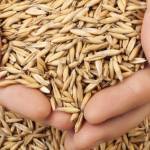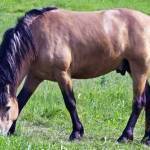Horse Feed Costs Impacted by Several Factors

Looking at your monthly bill from the local feed store is sometimes almost overwhelming. Yes, horses are large animals that eat a lot; still, that bill seems to be inflating every time you turn around. Why is horse feed so expensive? And why does the premier feed in the fancy bag cost twice as much as the plain-packaged brand at the local ag co-op? You want your horses to get good nutrition, but are you really just paying for pretty pictures, a big name, and lots of hype?
Some answers can be found in a report sponsored by several national food and feed industry organizations including the American Feed Industry Association and the Council on Food, Agricultural, and Resource Economics. To prepare the report, experts looked at current trends and predicted future changes in worldwide crops, biofuel demand, and patterns of livestock and poultry production. As horse owners, sometimes it’s easy to forget that there are many uses for a finite grain supply, and heavy demand means grain prices will be pushed up in every area of consumption.
According to the report, agriculture has thus far been able to keep up with the challenge of feeding an increasing world population. With an expected two billion humans being added in the next 50 years, however, demand for grains will increase, not just to be eaten in the form in which they are harvested but also to be fed to animals as people reach for a higher standard of living where more meat and fewer grains are eaten.
Growing more grain will necessitate developing varieties with better yields; utilizing more cropland; finding ways to bring water to dry agricultural areas; buying more fertilizer and insect spray; and acquiring more tractors, tillers, harvesters, trucks, and storage units. Each of these changes increases the cost of the grain by the time it reaches the consumer.
Post-harvest waste from spillage, mold, and contamination and consumption by insects and rodents is estimated to be as high as 30%. Improving transportation and storage of grain products to eliminate waste could theoretically increase the available supply, though at some additional cost to cover the upgraded technologies and equipment.
One bright note in the US is that government-mandated ethanol blending levels will reach their peak in 2015. This fact, plus a domestic ethanol market that has reached saturation, may ease corn demands. However, if harvests are depressed again by weather, as they have been in the last two or three years, expected yields won’t be reached and corn prices may stay elevated.
Back to the question of horse feed prices: Multiple demands for grain, varying weather patterns, and costs for quality feed ingredients (the most bioavailable forms of vitamins and minerals) have all played a part in what owners pay for a bag of feed. While fancy bags are somewhat more expensive to produce, their impact is less important than other factors that boost feed prices. So, what economic options do horses owners have?
As our national economy takes a slight upturn, horse owners will most likely continue to see some increase in feed prices. Some of the factors that caused recent upsurges might not be so detrimental in the future (good weather may be more conducive for high yields, for example), and consumers may realize a slight relaxation in prices. By taking a few minutes to closely examine your management schemes, you might be able to find ways to cut costs. Here are a few examples.
Take a critical look at body condition. Some owners like to see their horses fleshier than need be. Optimal body condition occurs when the ribs cannot be seen but can be felt on gentle palpation. Overweight horses are often a strain on the horse owner’s budget because they consume too much concentrate. Horses that maintain their weight on forage-only diets do not usually require any concentrate. A well-formulated balancer pellet will ensure that vitamin and mineral needs are being met.
Maximize forage use. Horses have evolved on diets composed entirely of forage. Therefore, forage should be the primary component of a horse’s diet. While all forage offered to horses should be free of dust, mold, weeds and foreign debris, the quality of the forage can vary depending on the type of horses being fed. Weanlings and yearlings, for instance, will likely fare better on an alfalfa mix as it contains more energy and nutrients for growth, but the same hay might be completely inappropriate for a group of idle geldings. Work with an equine nutritionist to ensure that you are using appropriate forage for the horses you are feeding. Likewise, contact an agronomist or a pasture specialist to be sure you are getting the most out of your grazing acreage.
Be suspicious of feed manufacturers that have not raised their prices. The price of all feed ingredients has increased. Add in the rising cost of other ingredients such as vitamins and minerals, and feed prices are bound to rise. To maintain the quality of feed, manufacturers must ask consumers to help shoulder the financial burden. If a feed manufacturer does not increase prices, there is a possibility that premium-quality grains are being replaced by less expensive ones, which invariably lowers the nutritional content of the feed.
Buy high-quality horse feed. Certain horses require fortified concentrates to grow and work because they cannot consume sufficient calories through forages to grow to their genetic potential or to maintain optimal body condition. When concentrates are necessary, be sure you are feeding high-quality, fully fortified feeds. Low-end brands often do not contain sufficient fortification to adequately support growth or exercise. Though premium feeds may have a higher cost at the counter, there is no comparison as to nutritional value.








